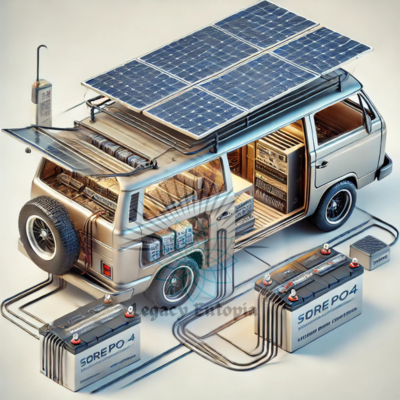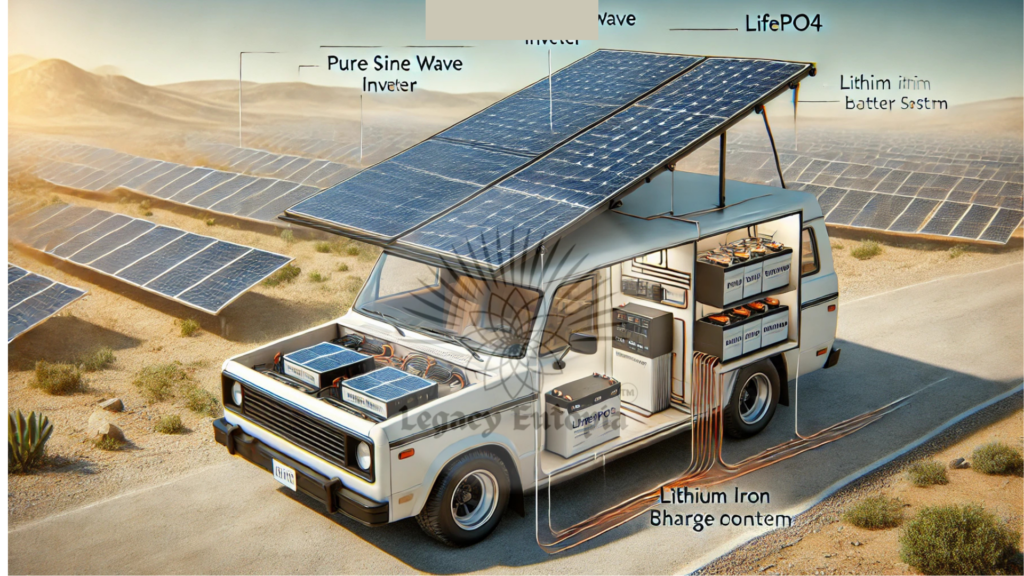Solar Powering a Vehicle with 800 Watts Peak 🚗
- Solar Powering a Vehicle with 800 Watts Peak 🚗
- Goals and Requirements for Solar Powering a Vehicle
- Recommended Solar Panel Setup for Vehicles
- Battery Storage for 800-Watt Solar Power
- Inverter for Vehicle Solar Power Setup
- Solar Charge Controller for Energy Efficiency
- Example Setups for Solar Power Management
- Optional Components
- Cost Overview Graph
- Estimated Cost
- Why This Setup Works
Solar powering a vehicle with 800 watts peak? Learn how to build a reliable setup with efficient components, solar panels, and modular power system. Allowing multiple appliances and devices in a vehicle setup.

RELATED CATEGORY: Resources and Templates
Attaching Solar Panels to Roof Rack
Cheapest Place to Live in America
Use Solar Panels to Charge Your Tesla
800 Watt Solar Power Vehicle Setup (you are here)
Tesla Using a Portable Power Station
Tesla Solar Panel Installation
Tesla Traveling Across the United States
Solar Powering a Vehicle with 800 Watts Peak: Goals, Components, and Setup
Goals and Requirements for Solar Powering a Vehicle
To solar power a vehicle with 800 watts, you need a system that delivers sufficient energy for extended use. A compact and efficient design is crucial for vehicle setups. Achieve optimal performance with a modular solar and battery system to meet energy demands.
- Power the gaming computer (up to 800W peak, typically 500W) for up to 8 hours/day.
- Compact and portable design for vehicle use.
- Efficient battery and solar setup to support extended use.
Recommended Solar Panel Setup for Vehicles
To solar power a vehicle with 800 watts, monocrystalline panels offer efficiency and portability.
Recommendation: Portable or flexible monocrystalline panels for vehicles.
2–4 panels rated at 200–300W each.
-
- Total capacity: 400–1200W (depending on available space and energy needs).
Flexible Solar Panels for vehicle use:
-
- Example: Renogy 200W Flexible Solar Panel.
- Ideal for mounting on curved surfaces like RV roofs or car roofs.
Battery Storage for 800-Watt Solar Power
To solar power a vehicle with 800 watts, reliable battery storage is essential.
Recommendation: Lithium Iron Phosphate (LiFePO4) battery (compact, lightweight, and safe).
-
- 2–4 kWh total storage capacity.
- Example: Battle Born 100Ah 12V LiFePO4 Battery (1.2 kWh per battery).
- Combine 2–4 batteries in parallel or series, depending on your inverter and system voltage.
Inverter for Vehicle Solar Power Setup
To solar power a vehicle with 800 watts, a pure sine wave inverter protects sensitive electronics.
Recommendation: Pure sine wave inverter (critical for sensitive electronics like gaming computers).
-
- 2000–3000W inverter to handle peak loads.
- 12V or 24V input, 120V output.
- Example: Victron Energy Phoenix Inverter 12/2000 or 24/3000.
Solar Charge Controller for Energy Efficiency
To solar power a vehicle with 800 watts, efficient charging is crucial.
Recommendation: MPPT Solar Charge Controller (Maximum Power Point Tracking) controller for efficiency.
-
- Use an MPPT controller.
- Example: Victron SmartSolar MPPT 100/50.
- Can handle up to 50A of current from solar panels.
Example Setups for Solar Power Management

500W Daily Use (4–6 Hours)
- 2x 200W solar panels (400W total).
- 2x 100Ah LiFePO4 batteries (2.4 kWh total).
- 2000W inverter.
- 40A MPPT solar charge controller.
Full-Day Use (8 Hours)
- 4x 200W solar panels (800W total).
- 4x 100Ah LiFePO4 batteries (4.8 kWh total).
- 3000W inverter.
- 50A MPPT solar charge controller.
Optional Components
- DC-DC Charger: Charges the battery bank efficiently while driving, simultaneously utilizing the vehicle’s alternator. Example: Renogy 40A DC-DC MPPT Charger.
- Monitoring System: Monitor energy input/output and battery status. Example: Victron Color Control GX or SmartShunt.
- Portable Power Station (Alternative): Example: EcoFlow Delta Pro or Bluetti AC200P (built-in battery, inverter, and solar input).
Cost Overview Graph
Estimated Cost
| Component | Cost Per Unit | Quantity | Total Cost |
|---|---|---|---|
| Solar Panels (200W) | $200–$400 | 2–4 | $400–$1,600 |
| LiFePO4 Batteries (100Ah) | $800–$1,200 | 2–4 | $1,600–$4,800 |
| Inverter (2000–3000W) | $300–$600 | 1 | $300–$600 |
| Solar Charge Controller | $150–$300 | 1 | $150–$300 |
| DC-DC Charger | $200–$400 | 1 | $200–$400 |
| Total Setup Cost | $2,650–$7,700 |
Why This Setup Works
- Modular System: Start with minimal components at first, and then gradually expand later as needed.
- Portable Design: Compact panels fit vehicle installations.
- Reliability: High-quality components ensure consistent performance.
SpiritFairie Whispers on Youtube
